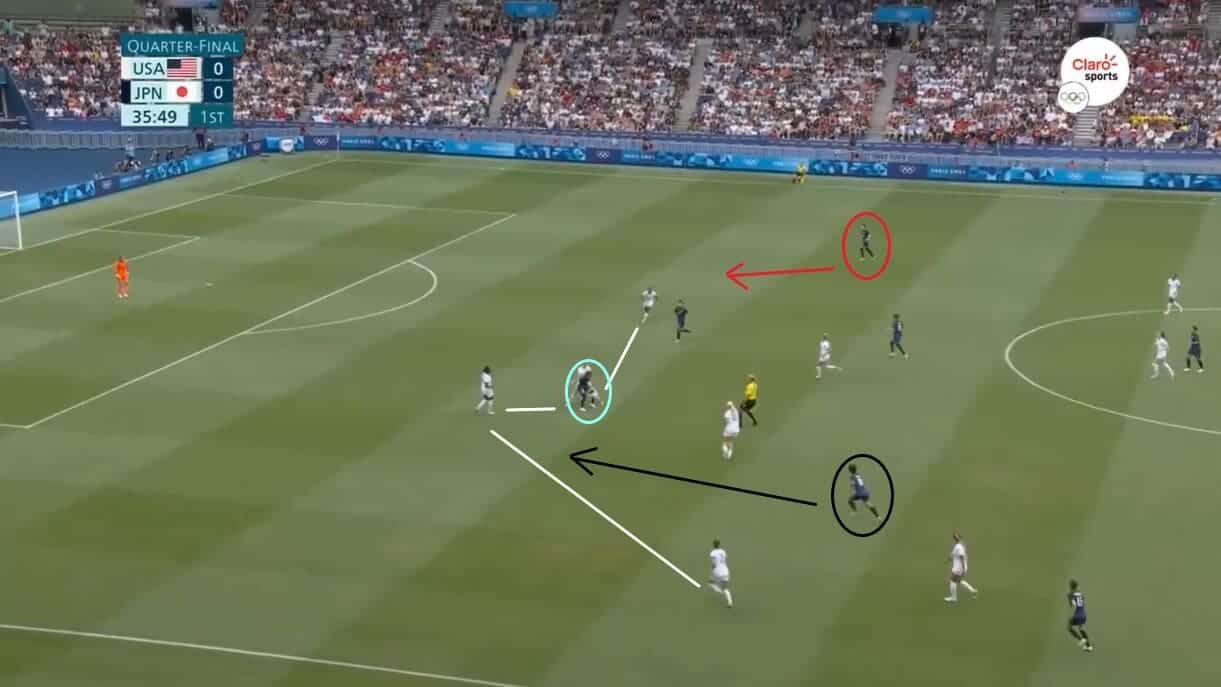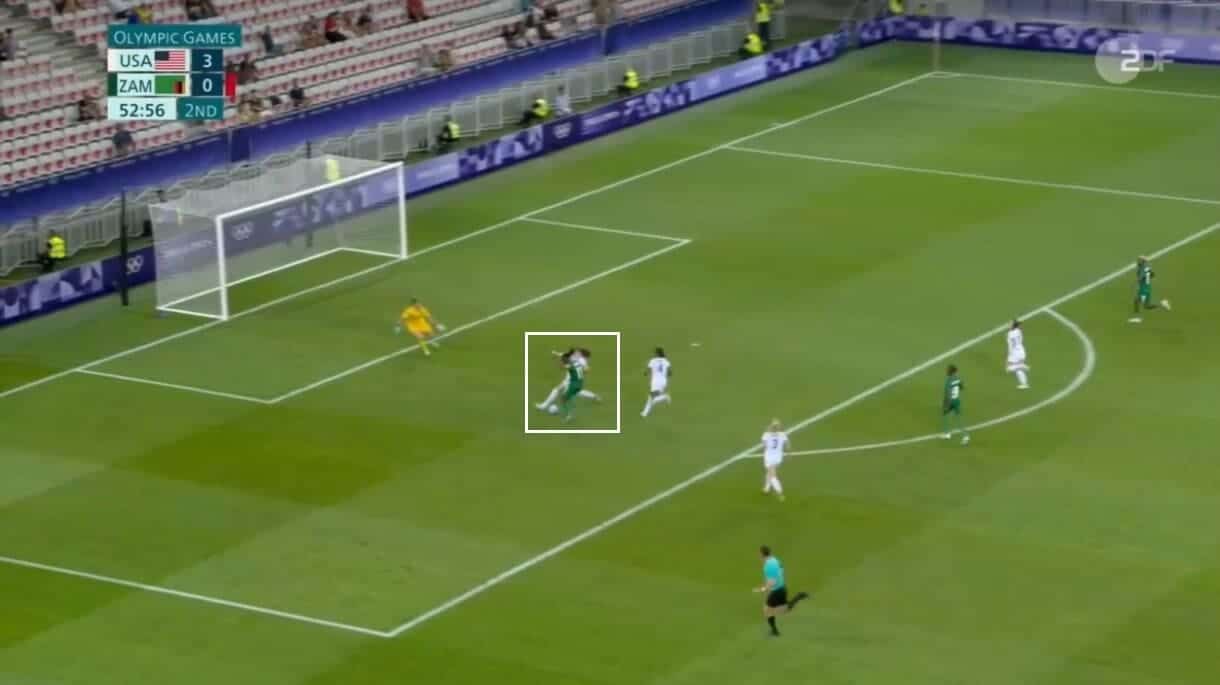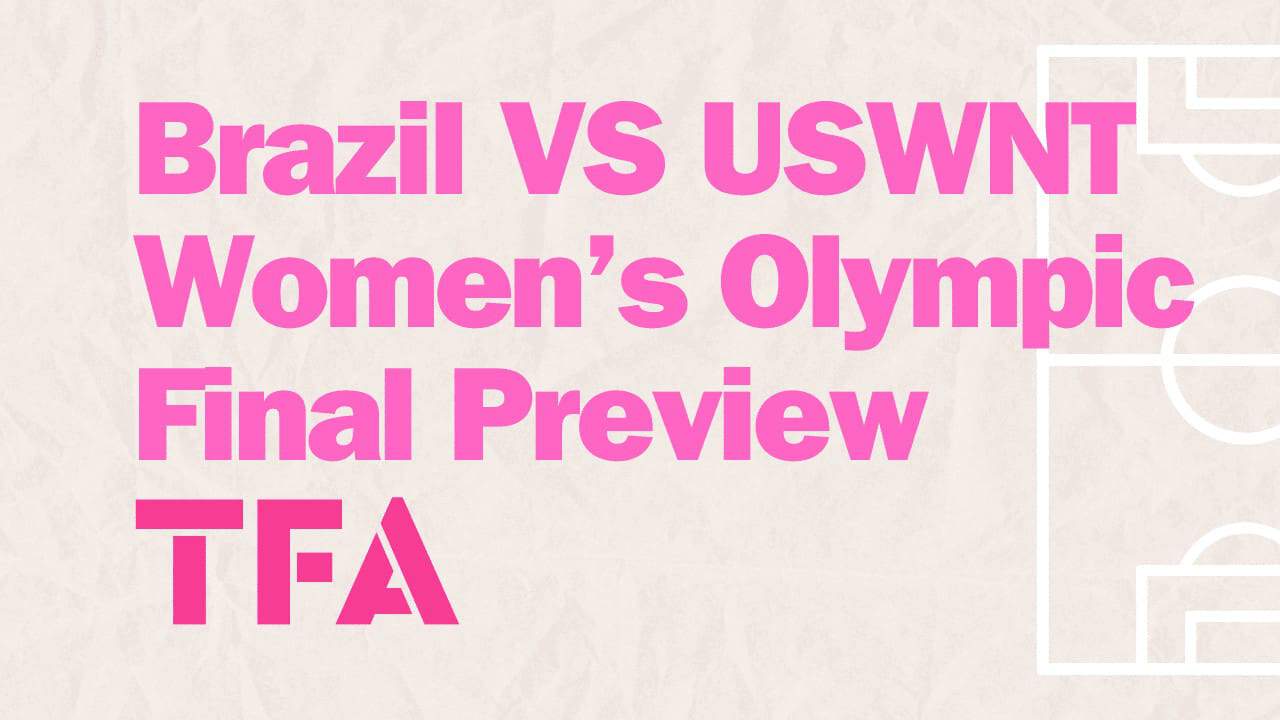After just over two weeks of exhilarating action, the Olympic women’s football tournament reaches its endpoint this weekend, with Brazil and the USA fighting it out for the chance to complete their time at the Games with a gold medal around their necks.
It is set up to be a mouthwatering encounter, not only because it will pit two of the game’s heavyweights against each other but also because it will be a clash of playing styles, with Brazil favouring front-footed, attack-minded tactics under head coach Arthur Elias and the USA adopting a more measured approach under his counterpart Emma Hayes.
This tactical analysis will provide a full preview of what fans can expect from the 2024 women’s football gold medal match, highlighting the game plans that each side could deploy and looking at what each coach can do to gain an advantage over the other.
The analysis will also identify key players on each side who could have an impact on the day and will indicate why involving them as much as possible could make the difference between victory and defeat.
Brazil’s Attack
Ever since Elias took charge of Brazil last year, he has been looking to transform his side’s mentality and to make them a more proactive outfit, with his preferred style of play as Corinthians Femenino’s head coach based around energy and dictating the tempo of their games.
These are qualities that the Brazilian national side has taken to just as well as the São Paulo-based side did, and there is no doubt that playing with that philosophy has been instrumental in them reaching the last two.

One of the key demands that Elias has is for his team to press high up the field, which was most evident during the semi-final against Spain.
Brazil knew going into that game that the reigning world champions would seek to play out from the back whenever possible, with it being a key part of their own DNA, and so recognised that there would be opportunities for them to apply pressure and to force mistakes.
As the match went on, this strategy proved successful.
They got on the front foot from the first whistle (another of Elias’s key demands) and scored within the opening stages, with goalkeeper Cata Coll’s hurried clearance ricocheting into the back of the net off her Barcelona Femení teammate Irene Paredes.
It would be wrong to say, though, that this is simply Brazil pushing up the pitch at once, with their being a method to the way that they instigate the press so as not to allow their opponents to simply play around them.
In this case, it started with the infield pass from Real Madrid Femenino left-back Olga Carmona towards new Arsenal Women recruit Mariona Caldentey being forced to go backwards.
Then it came down to the front two of Priscila and Gabi Portilho closing down Paredes and Arsenal defender Laia Codina first and then moving in on Coll once the latter had made the backpass.
While the goal’s timing was unfortunate, Brazil’s ingenuity in creating the scoring opportunity is unquestionable, and the coordination shown here makes their 1.4 goals scored per game unsurprising.

When it comes to their transitions, Elias tended to favour more centralised build-up play whilst in charge of Corinthians, with his desire being to create numerical overloads in interior spaces.
However, since taking over the Brazilian national team, he has moved away from that policy, and many of their attacks have instead revolved around greater use of the wide channels.
The reason that this has been another of their key strengths is largely down to the willingness of their full-backs or wing-backs (depending on which formation they are in) to get into advanced spaces and to give the team ways to move the ball up the field.
It can be seen here how both Tamires and Antônia are ahead of the central defensive duo and so are doing just that.
At this stage, Brazil starts to climb through the gears, with former Arsenal defender Rafaelle passing towards Tamires and the Corinthians left-back, then turning and carrying the ball into the opposing half.
Once she gets a certain distance up the pitch, her attention switches towards finding a teammate inside her to aim her cross at, which here comes in the shape of Portilho on the far side of the goal area.
On this occasion, Osinachi Ohale’s attempted aerial interception temporarily knocked the ball off course, but that didn’t prevent it from finding the in-form attacker, and Brazil was, therefore, able to try their luck in front of Nigeria’s goal.
The efficiency of this sequence and the understanding shown by each player explain why Brazil was able to move the ball from one end of the field to the other in just three passes.
The fact that their passing accuracy currently stands at 71.2% indicates that this is another reason that they have a chance of winning the gold medal.
It can be expected that they will play with the same fluency when they face the USA at the weekend, and doing so will certainly make them a difficult side to contain.
Brazil’s Defence
If they are to succeed in their quest for glory, they will need to marry that attacking threat with solidity at the back.
This is something that they have not been as proficient in in recent years, but it has been a key improvement in their game under Elias and has played its part in getting them to this stage of the competition.

In many ways, what has made them so tough to score against is the anticipation shown by those in the back line, and Rafaelle is one player who has really epitomised that desire to get into areas from which they can break up opposing attacks.
As is indicated here, she has recognised the intention that new Chelsea Women’s winger Sandy Baltimore has of setting up a teammate inside her and so has positioned herself in the right place to intercept the cross.
By doing so, she brings France’s attack to a premature end and demonstrates how she is just as capable of aiding her team in defensive situations as she is when they are looking to launch attacks from the back.
This is not the first time that the Orlando Pride player has demonstrated her qualities without the ball during the tournament, with a number of Brazil’s opponents coming up short in these areas of the pitch due to her anticipation and ability to position herself well.
It has been a strength of hers throughout her career, with Arsenal in particular really relying on it during her time at the London side.
Brazil will hope that she continues to offer this when they face the USA, who have tended to build attacks in a similar manner, on Saturday.

As mentioned, though, it is a team effort, and every player in the back line has contributed to making Brazil such a tricky side to score against.
In this case, Japan has made its way up the field, and INAC Kobe Leonessa’s Miyabi Moriya is now looking to send the ball into the goal area.
However, she was quickly closed down by Antônia whilst left wing-back Yasmim tucked in to ensure that Brazil could maintain a four-player structure in front of goal.
It is that final point that is the key thing to note here.
Teams that play with a back four and then see one player move out to close an attacker down often leave themselves exposed and easy to play through.
If Yasmim had stayed in her usual position, Japan would have likely been able to cross the ball into the middle and have had a chance to shoot at goal here.
The fact that Brazil had that additional player meant they could stop it from reaching Manchester United Women’s Hinata Miyazawa, with Yasmim making the vital intervention.
Once again, this highlights the awareness that is rife within Brazil’s structure inside their own third.
When coupled with the 67.6% of defensive duels and 40.5% of aerial contests that they have succeeded in so far at the Games, it shows how they have generally had the answers when tested by opposing players.
They are not perfect, and the fact that they have conceded 1.2 goals per game indicates that there are still chinks in their armour, but they will certainly not make it easy for the USA to find the back of the net.
The USWNT’s Attack
As was made clear at the beginning of the analysis, a very different brand of football can be expected from the USA, with their on-field attitude being tuned more towards retaining the ball and not taking too many risks when they do have it within their possession.
Considering that they have averaged 66.83% possession and have scored 2.2 goals per game, this has certainly not been a bad policy for them to employ.

One of the things that will feature heavily in their play is players staying wide and the team operating in an expansive manner, with that being common to see both in the build-up to and during their Olympic campaign.
The reason that they have sought to stay tight to the sidelines at all times is because it then allows them to make diagonal passes around the field, probing their opponents and hunting for ways through them.
It also increases the chance of gaps opening up through the middle as sides are forced to shift continually from side to side and slowly lose the shape that they initially set up in.
Against Australia and Germany, that proved to be especially effective in allowing them to create chances in dangerous positions, with Rose Lavelle bringing the ball across the pitch here and Crystal Dunn then sending it back towards Trinity Rodman, and it was not long before Australia began to unravel and to give the USA an opportunity to attack between their lines.
It was at that stage that those more adept at connecting the dots in central areas went to work, with San Diego Wave centre-back Naomi Girma and Lyon Féminin midfielder Lindsey Horan among them.
The USA’s 87.2% passing accuracy so far highlights how precise they are when creating chances in this manner.

The other thing that has been evident in the USA’s attacking play is their structural balance, with Dunn moving up the field and Arsenal right-back Emily Fox slotting in as an additional centre-back, whilst Rodman has changed from a role in the forward line to act as the right winger.
This then creates those natural passing routes for the ball to travel through without leaving spaces unprotected and enables each player to get into areas from which they can play to their strengths.
This is epitomised here by Rodman, with the Washington Spirit attacker’s 1-v-1 ability well-known among NWSL and USWNT fans and this positional shift allowing her to show that during the Olympic matches.
In this case, she has Marina Hegering ahead of her and space to demonstrate her sharp footwork.
As a result, she is able to take the ball around the Wolfsburg Frauen defender and get a shot away at goal.
With her winning 48.6% of her offensive duels in France so far and averaging 5.93 touches inside the penalty area, moments like this have been a constant feature of the USA’s attacks.
They mirror a lot of what made Chelsea so dangerous under Hayes last season, too.
In her final campaign at the Kingsmeadow helm, their game plan was based around Sweden winger Johanna Rytting Kaneryd maintaining the width and hugging the touchline, just as Dunn has tended to do, and allowing England forward Lauren James to make the same inverted runs as Rodman has.
It was a dynamic that worked well for the WSL’s reigning champions, and it has proven to be just as effective in taking the USWNT to the Olympic final.
The USWNT’s Defence
Where the USA have experienced a few issues is once they lose the ball, with them largely keeping opponents at bay and conceding just two times in their five matches so far, but undoubtedly having some moments when they have left themselves too open, and so have invited pressure.
With Brazil having the ability to punish mistakes, as evidenced earlier in the preview, this is something that they will need to avoid if they are to leave France as Olympic champions.

The reason for these occasional lapses in defensive security comes when they try to move out and close the ball down, and this is why Brazil’s ability to stay in a tight four-player line has been so important.
In this case, Fox has moved out to press the ball just as Antônia did earlier and has similarly failed to prevent the ball from being played into a dangerous area.
It looks initially as though the USA can manage the situation due to Yui Hasegawa having her back to goal when the ball arrives at her feet, but what the USA have failed to notice is the run made by new Brighton and Hove Albion striker Kiko Seike between Fox and Horan.
This is where having that additional defender could have helped the USA out, but they didn’t.
As a result, they left themselves exposed and allowed the Manchester City Women midfielder to roll the ball towards Seike, who then sent it over the top for Hasegawa’s new clubmate Aoba Fujino to get on the end of.
Dunn did prevent that from happening, but she was powerless to stop Moriya from controlling the ball and shooting at goal instead.
The fact that this all came about as a result of Fox’s attempt to move out of line shows how perilous these moments can be for the USA.
Therefore, if they are to keep Brazil at arm’s length, this is what they will need to find a way of remedying.
They have won 67.1% of their defensive duels and 55.9% of their aerial battles, so it is difficult to be too harsh, but it is these situations when they lose their concentration that could make the difference on the day.

One of the stronger elements of their defensive play has been their ability to negate the threat of counterattacks.
That was apparent in their opening match against Zambia, as the African nation’s tactics were based on absorbing pressure before hitting their opponents on the break.
That didn’t work out for them because of the combined efforts of Girma and Tierna Davidson.
The central defensive pair was immense in that match and constantly prevented star striker Barbra Banda from troubling the USA’s goal.
Like Brazil, it was their anticipation that allowed them to keep the Orlando striker under wraps, with Davidson making the tackle here.
Still, Girma winning 66.7% of her defensive duels and 53.3% of her aerial battles as the tournament has gone on and so been just as instrumental.
With Brazil not only having the pace and pressing threat of Priscila, Portilho, and Ludmila, to name just a few, but also seeing 62.5% of their own counterattacks end in a shot on goal, having defenders who can play with this level of alertness will be vital in the gold medal match. It will be critical that both are in top form if the USA are to emerge triumphant from the encounter.
Brazil & USWNT Key Players
Throughout this analysis, an abundance of key names have been mentioned who will all be paramount to their teams’ chances of securing the gold medal.
However, there are others too who have contributed to their sides’ performances and yet who have not earnt as many plaudits for their efforts.
They will undoubtedly be just as vital, though, and so deserve to be highlighted.

Brazil’s robustness out of possession has already been examined in great detail, and there is no doubt that they will have to play with a high level of organisation and coordination if they are to keep the USA’s in-form attacking trio of Rodman, Sophia Smith, and Mal Swanson at bay.
With that in mind, one player to keep a close eye on will be Lauren.
The Kansas City Current defender may not receive as much attention as Rafaelle and Tarciane, but she is arguably the reason her nation has made it to the gold medal match.
She has made some crucial blocks and tackles to keep teams out when it has looked as if they have been through on goal.
As this graphic indicates, though, she is capable of pushing out to win the ball early and making those last-ditch contributions.
The fact that she has won 75% of her aerial duels, 60.7% of her defensive battles, and 5.26 interceptions per match highlights how she could make a huge difference between Brazil taking the gold medal home and finishing with the silver one.

The USA, too, will need to be robust and not allow Brazil to test them too often, and that will come down to the presence of Sam Coffey in front of the back line.
The Portland Thorns midfielder is another player who has played a critical role in her team’s fortunes but who has not been celebrated as much.
Undoubtedly, the USA would not have been competing in the gold medal match without her.
It is her all-round game that has made her such a valuable asset for Hayes to have in her team, with her winning 76.2% of her defensive duels and making 1.85 interceptions per game, making her the perfect defensive guard, but also passing out from the back with precision too.
This graphic illustrates that latter point, and it is clear to see how she has been responsible for launching so many of her side’s attacks from deeper areas, with 88.3% of her passes finding their intended target.
With that in mind, there is no doubt that she is someone that her side relies on to play the supporting role and to ensure that every other aspect of their play works to its full potential.
It was telling that USWNT fans were concerned about their prospects of making it through their quarter-final match against Japan.
Coffey was suspended for that outing due to yellow card accumulation, and that indicates just how vital her presence is to their operating at their best.
Conclusion
In conclusion, this 2024 Women’s Olympic final tactical analysis has looked in detail at the upcoming gold medal match between Brazil and the USA, previewing all of the action and highlighting what fans can expect tactically from each side as the game goes on.
It might not have been the matchup that many predicted for the final, but what has become apparent throughout the preview is that they have arguably been the best teams throughout the competition. Brazil’s high-pressing style of play makes life incredibly difficult for their opponents, while the USA are turning a corner under Hayes and are on an upward trajectory as they continue moving into their new era.
Both sides have given a lot to get to this stage, and it now comes down to one game to see which of them will be crowned as the 2024 Olympic champions.
Deciding which team does achieve that could well come down to bravery with tactical calls and which players have the extra something to help their sides gain an edge.
It is going to be fascinating to see who does come out on top.





Comments